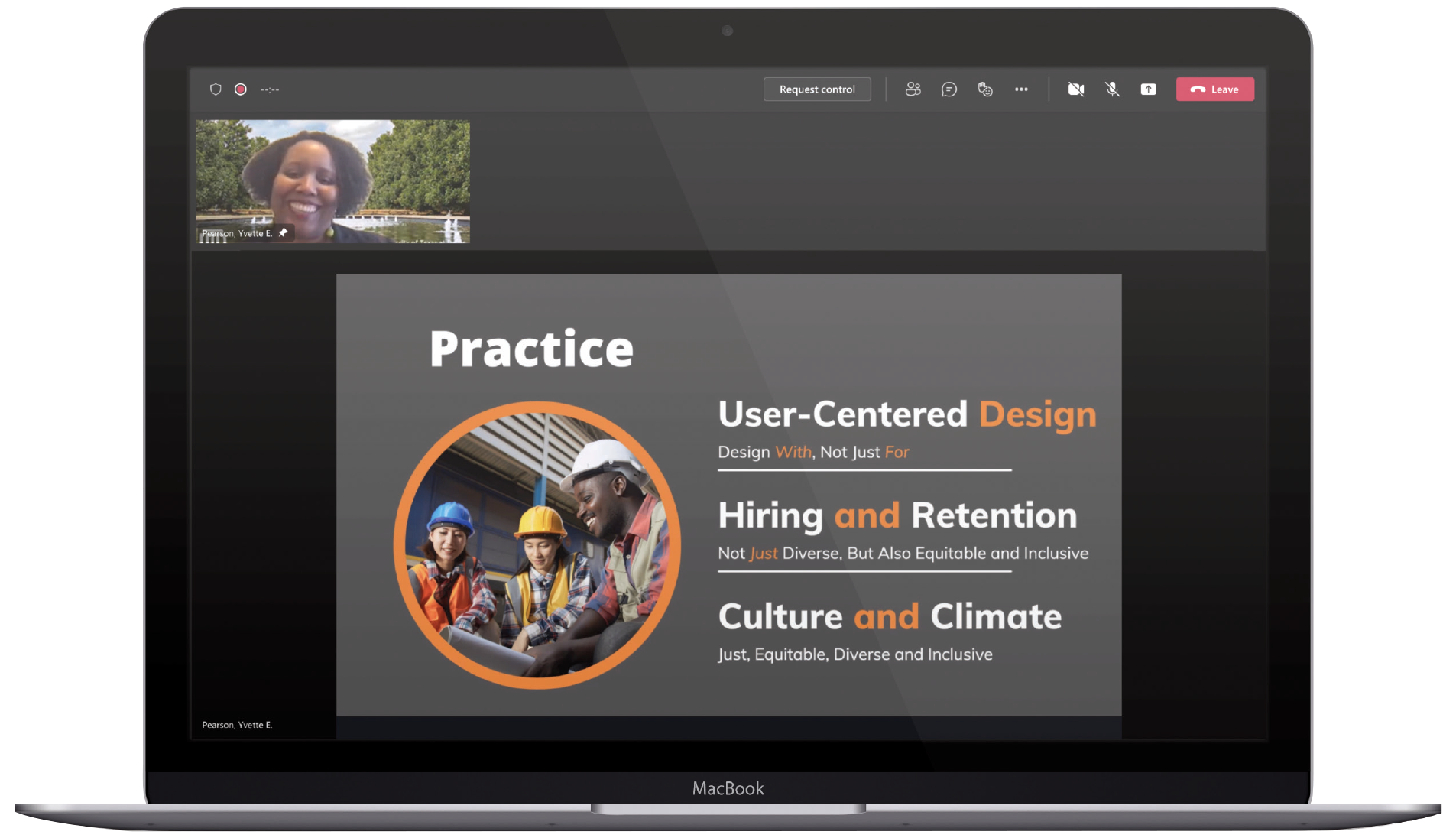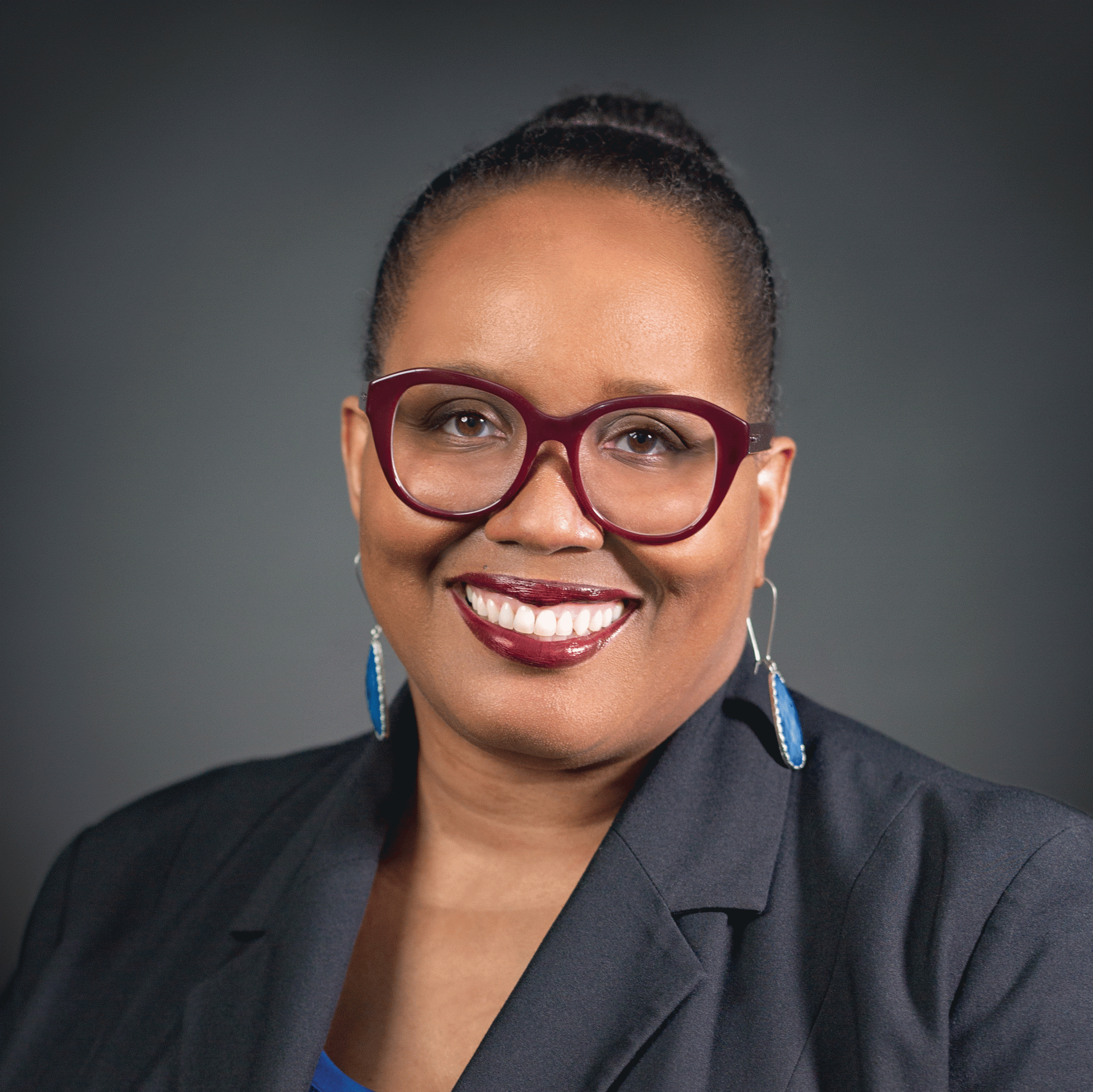
Dr. Yvette Pearson, vice president for diversity, equity and inclusion at UT Dallas, tells audience members that user-centered design integrates the entire user experience throughout the iterative process.
I n the wake of George Floyd’s murder in 2020, corporations and organizations rushed to issue statements emphasizing their commitments to diversity and social justice. Dr. Yvette E. Pearson, vice president for diversity, equity and inclusion at The University of Texas at Dallas, worked with the American Society of Civil Engineers (ASCE) leadership at that time to issue a similar statement in her role as inaugural chair of Members of Society Advancing an Inclusive Culture (MOSAIC), a board-level ASCE committee.
What disheartened Pearson afterwards was that an engineer asked the question, “What does social justice have to do with engineering?”
Pearson attempted to answer that question when she delivered the Dean’s Distinguished Lecture at the Erik Jonsson School of Engineering and Computer Science via Microsoft Teams in 2022. The invited lecture marked an introduction to Pearson’s vision for a focus on justice, equity, diversity and inclusion (JEDI) principles to be incorporated at school, university and societal levels. Dr. Stephanie G. Adams, Jonsson School dean and Lars Magnus Ericsson Chair, invited Pearson to deliver the lecture a few months after she joined UT Dallas. Pearson titled her lecture “Connecting the Dots: Engineering, Ethics and Equity.”
“I am pleased to call Yvette my colleague and friend,” said Adams, also professor of systems engineering. “Engineering design and inclusion are inextricably connected, and I knew that members from across the Jonsson School could benefit from hearing how they can participate in more equitable, effective engineering practices. We are so fortunate to have someone with Yvette’s caliber of expertise at UT Dallas.”
Pearson is a civil engineer who previously served as associate dean for accreditation, assessment and strategic initiatives in the George R. Brown School of Engineering at Rice University. She was recently awarded the 2021 President’s Award from ASCE, the 2021 Distinguished Engineering Educator Award from the Society of Women Engineers and the 2019 Claire L. Felbinger Award for Diversity and Inclusion from the Accreditation Board for Engineering and Technology (ABET). She earned bachelor’s and master’s degrees at Southern University and her PhD in engineering and applied science from the University of New Orleans.
CHANGING PERCEPTIONS
Pearson introduced several problems that demonstrate disparate outcomes for specific populations stemming from bias and systemic inequity. She cited a statistic from the Centers for Disease Control and Prevention indicating that Black women are three times more likely to die from a pregnancy-related cause than white women but that the gap closes when Black women are under the care of Black physicians. She cited a Georgetown University study showing a 36% higher mortality among pedestrians using wheelchairs and discussed National Institute of Standards and Technology findings on how Asian and African American people are up to 100 times more likely to be misidentified by facial recognition technology, with Native Americans having the highest rate of being falsely identified. Finally, she explained a Fort Worth Star-Telegram report on how people in that Texas city in a predominantly African American, lower-income community on average will not live to the age of 67 despite living in close proximity to high quality hospitals.
“What’s the common thread that connects all of these problems?” Pearson asked.
“The answer is that they are very strongly rooted in inequities that we see in science, technology, engineering, mathematics and medicine (STEMM). It’s not only in the practice of those areas, but it ties back to what we are doing in terms of education and research in those spaces as well.”
Pearson’s lecture addressed the question, “What does social justice have to do with engineering?”
One key concept that Pearson discussed is that a diverse group of stakeholders should be engaged throughout research and problem-solving processes. Rather than manipulating a group of people from the outside, researchers should use asset-based approaches that acknowledge the unique insights people bring from their experiences.
“When we see deficits, it’s not in the people but in the systems that have been marginalizing and disadvantaging populations,” Pearson emphasized.
In the classroom, Pearson said, faculty can apply Universal Design for Learning (UDL) principles. She cited Process-Driven Math (PDM) as one means of doing this. Mathematics is required in all majors; mastery of mathematics is critical for students who are interested in pursuing STEMM professions. With funding from the National Science Foundation (NSF), Pearson and her team at Auburn University at Montgomery, Auburn University and Rice have been studying the efficacy of PDM, a novel UDL-based method of teaching and assessing mathematics for all learners, in particular those with vision and/or print-related disabilities.
Researchers and practitioners can apply User Centered Design (UCD) in their work, seeking input from participants through an iterative process from problematization through solution as they seek to understand users’ needs and experiences while incorporating their feedback. Overall, the UCD framework is constructed to consider the entire user experience, not pulling together fragments of data but
integrating input throughout the process and drawing from experts in multiple domains, including lived experiences.
“I define ethics as doing the right thing and doing things right,” Pearson said.
She emphasized that multiple professional organizations including the Association for Computing Machinery, the American Institute for Chemical Engineers, the Institute for Electrical and Electronics Engineers, the National Society of Professional Engineers and the ASCE all have defined JEDI principles as expected standards of practice to varying degrees through their codes of ethics and their policies.
UT Dallas established the Living Our Values Task Force to learn more about how the University is addressing issues in the classroom and in the UT Dallas community.
Also at the University level, Adams and Dr. Inga H. Musselman, vice president for academic affairs, provost and holder of the Cecil H. Green Distinguished Chair of Academic Leadership at UT Dallas, are prinicipal investigators on a three-year, $1 million NSF-funded grant for ASPIRE2 (Adapting Succesful Practices to foster an Inclusive, Respectful and Equitable Environment), a project designed to address gender equity among faculty across the University. Musselman, who attended the virtual event, gave her support to Adams and Pearson for addressing the critical topic.
Discover More
Parallel Circuits
Six of seven children in the Fasolino family graduated from UT Dallas. From left to right: Christine BA'86; Michael BS'03; Mark BS'18, MS'19; father John and mother Stephanie; Stephen BS'09, James BS'20, MS'21 and Renee BA'05.The Fasolino family...
Ahead In The Count
Devyn Yanello, Conference Softball Player to WatchA lot can happen in the 43 feet between the pitcher’s mound and home plate. Standing on the rise, Devyn Yanello reads the sign from the catcher. Her unspoken intention — send the batter back to the dugout. Earlier this year, Yanello, a mechanical...
Love & Stem
Jonsson School faculty and staff members pose with their spouses who also work at UT Dallas at the iconic Love Jack sculpture on the University mall. Back row (from left to right): Tonya Griffin, senior director of finance and administration in the...
Leaving The Nest
IDEAS TAKING FLIGHT All innovation begins with a question, an idea. Researchers make big theoretical inquiries, examine microscopic problems or simply look out the window at practical issues ready to be tackled. The laboratory acts as a home — a...
A New Take On Royalty
JONSSON SCHOOL STUDENT ELECTED HOMECOMING KING Homecoming at The University of Texas at Dallas is designed to celebrate students and their unique experiences at a university with an internationally ranked chess team, nationally ranked esports team and no football team. In February 2022, University...
Scientist in the A.M., ‘Snack’ in the P.M.
Bioengineering PhD student Leroy Arthur was at a Dallas restaurant with friends when he received what seemed like a random message through his Instagram account, which shows a video of him skydiving and photos of him fashion modeling and spending time with friends and...

